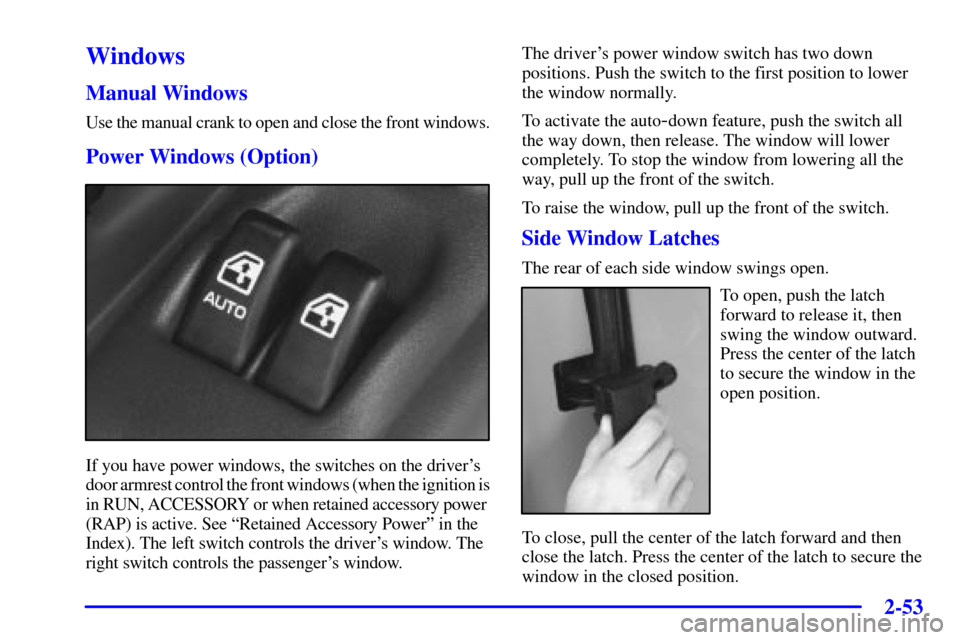Page 154 of 429

2-50 Torque Lock
If you are parking on a hill and you don't shift your
transaxle into PARK (P) properly, the weight of the
vehicle may put too much force on the parking pawl in
the transaxle. You may find it difficult to pull the shift
lever out of PARK (P). This is called ªtorque lock.º
To prevent torque lock, set the parking brake and then
shift into PARK (P) properly before you leave the
driver's seat. To find out how, see ªShifting Into
PARK (P)º in the Index.
When you are ready to drive, move the shift lever out of
PARK (P) before you release the parking brake.
If torque lock does occur, you may need to have another
vehicle push yours a little uphill to take some of the
pressure from the parking pawl in the transaxle, so you
can pull the shift lever out of PARK (P).
Shifting Out of PARK (P)
Your vehicle has an automatic transaxle shift lock
control system. You have to fully apply your regular
brakes before you can shift from PARK (P) when the
ignition is in RUN.
As you step on the brake pedal, while in PARK (P),
you may hear a click from the solenoid of the system.
This ensures that the system is operating properly.
See ªAutomatic Transaxle Operationº in the Index.
If you cannot shift out of PARK (P), ease pressure on
the shift lever
-- push the shift lever all the way into
PARK (P) as you maintain brake application. Then
move the shift lever into the gear you want. If you ever
hold the brake pedal down but still can't shift out of
PARK (P), try this:
1. Turn the ignition key to OFF.
2. Apply and hold the brake until the end of Step 4.
3. Shift to NEUTRAL (N).
4. Start the engine and then shift to the drive gear
you want.
5. Have the vehicle fixed as soon as you can.
Page 157 of 429

2-53
Windows
Manual Windows
Use the manual crank to open and close the front windows.
Power Windows (Option)
If you have power windows, the switches on the driver's
door armrest control the front windows (when the ignition is
in RUN, ACCESSORY or when retained accessory power
(RAP) is active. See ªRetained Accessory Powerº in the
Index). The left switch controls the driver's window. The
right switch controls the passenger's window.The driver's power window switch has two down
positions. Push the switch to the first position to lower
the window normally.
To activate the auto
-down feature, push the switch all
the way down, then release. The window will lower
completely. To stop the window from lowering all the
way, pull up the front of the switch.
To raise the window, pull up the front of the switch.
Side Window Latches
The rear of each side window swings open.
To open, push the latch
forward to release it, then
swing the window outward.
Press the center of the latch
to secure the window in the
open position.
To close, pull the center of the latch forward and then
close the latch. Press the center of the latch to secure the
window in the closed position.
Page 158 of 429
2-54 Power Rear Quarter Windows
(If Equipped)
This button, located in
the overhead console
switchbank, is used for
opening and closing
the power rear
quarter windows.
Press the top ribbed side of the button to open the
windows; both windows will open. The windows can be
opened fully or only a portion depending on how long
the button is pushed.Press the bottom symbol side of the button to close both
windows. The windows can be closed fully or only a
portion depending on how long the button is pushed.
The ignition must be in RUN, ACCESSORY or when
retained accessory power (RAP) is active to use the
power rear quarter windows. See ªRetained Accessory
Powerº in the Index.
Rear Side Panels (Cargo Van)
The windows on the cargo van are opaque glass.
These operate the same as the rear side windows in the
regular van.
Horn
You can sound the horn by pressing the horn symbols on
your steering wheel.
Page 165 of 429

2-61
Reducing Speed While Using Cruise Control
There are two ways to reduce speed while using
cruise control:
�Push in the SET button at the end of the lever until
you reach the lower speed you want, then release it.
�To slow down in very small amounts, push the
SET button briefly. Each time you do this,
you'll go 1 mph (1.6 km/h) slower.
Passing Another Vehicle While Using Cruise Control
Use the accelerator pedal to increase your speed. When
you take your foot off the pedal, your vehicle will slow
down to the cruise control speed you set earlier.
Using Cruise Control on Hills
How well your cruise control will work on hills depends
upon your speed, load and the steepness of the hills.
When going up steep hills, you may have to step on the
accelerator pedal to maintain your speed. When going
downhill, you may have to brake or shift to a lower gear
to keep your speed down. Of course, applying the brake
takes you out of cruise control. Many drivers find this to
be too much trouble and don't use cruise control on
steep hills.Ending Cruise Control
There are two ways to turn off the cruise control:
�Step lightly on the brake pedal, or
�move the cruise switch to OFF.
Erasing Cruise Speed Memory
When you turn off the cruise control or the ignition,
your cruise control set speed memory is erased.
Page 166 of 429
2-62
Exterior Lamps
Turning the dial to this setting turns on:
�Parking Lamps
�Sidemarker Lamps
�Taillamps
�Instrument Panel Lights
Turning the dial to this setting turns on the
headlamps, together with:
�Parking Lamps
�Sidemarker Lamps
�Taillamps
�Instrument Panel Lights
Turning the dial to this setting turns off all the lamps
and lights.
Lamps on Reminder
If the driver's door is opened and you turn the ignition
to OFF or LOCK while leaving the lamps on,
you will hear a warning chime.
Daytime Running Lamps
Daytime Running Lamps (DRL) can make it easier for
others to see the front of your vehicle during the day.
DRL can be helpful in many different driving
conditions, but they can be especially helpful in the
short periods after dawn and before sunset.
Page 167 of 429

2-63
A light sensor on top of the instrument panel makes the
DRL work, so be sure it isn't covered. The DRL system
will make front parking and turn signal lamps come on
in daylight when:
�The ignition is on,
�the headlamp switch is off, and
�the parking brake is released.
When the DRL are on, only your front parking and turn
signal lamps will be on. Your instrument panel won't be
lit up.
When it's dark enough outside, the exterior lamps will
come on automatically. When it's bright enough outside,
the exterior lamps will go out and the DRL will turn on.
Of course, you may still turn on the headlamps any time
you need to.
To idle your vehicle with the DRL off, set the parking
brake while the ignition is in OFF or LOCK. Then start
the vehicle. The DRL will stay off until you release the
parking brake.
As with any vehicle, you should turn on the regular
headlamp system when you need it.Interior Lamps
Instrument Panel Intensity Control
Turn the control, located below the headlamps switch,
clockwise to increase the brightness of the instrument
panel lights, and counterclockwise to decrease the
brightness. Turn the control all the way
counterclockwise to turn them off.
Interior Lamps Control
Turn the dial all the way clockwise to turn on the
interior lamps, if the interior lamps override switch is
off. Turn the dial counterclockwise to turn the lamps off.
Page 168 of 429

2-64 Interior Lamps Override Switch
This switch is located
in the overhead
console switchbank.
Press the symbol on the bottom of the switch to override
control of the interior lamps and turn off power to the
courtesy lamps, reading lamps, visor vanity lamps
(if equipped) and glove box lamp. This feature allows
you to have the lamps off when any door is open.
Press the top of the interior lamps override switch to
turn power back on to the interior lamps. This will allow
the lamps to stay on when any door is open.
Illuminated Entry
With illuminated entry, the interior of your vehicle is
illuminated so you can see inside before you enter your
vehicle. The lamps will come on for 40 seconds if you
unlock your door using your key or the remote keyless
entry transmitter (if equipped) and the ignition is in
LOCK or OFF. After 40 seconds have passed,
the interior lamps will slowly fade out. The lamps will
turn off before the 40 seconds if you:
�Lock all the doors using the key,
�press LOCK on the power door lock switch, or
�press LOCK on the remote keyless entry transmitter
(if equipped).
When any door is opened, illuminated entry is cancelled.
The interior lamps will stay on while any door or the
liftgate is open, and slowly fade out when all doors and
the liftgate are closed.
The interior lamps may stay on for up to 25 seconds
after all doors have been closed if they have not been
locked. See ªDelayed Illuminationº later in this section.
To turn the exit lighting feature off or on, see
ªMultifunction Alarm Locks and Lighting Choicesº in
the Index.
Page 169 of 429

2-65
Delayed Illumination
The delayed illumination feature will continue to
illuminate the interior for 25 seconds after all doors have
been closed so that you can find your ignition and
buckle your safety belt at night. Delayed illumination
will not occur while the ignition is in RUN or
ACCESSORY. After 25 seconds have passed,
the interior lamps will slowly fade out. The lamps will
fade out before the 25 seconds have passed if you:
�Turn the ignition to RUN or ACCESSORY,
�lock all doors using the remote keyless entry
transmitter (if equipped), or
�lock all the doors using the power door lock switch
or the key.
To turn the delayed illumination feature off or on, see
ªMultifunction Alarm Locks and Lighting Choicesº in
the Index.
Exit Lighting
With exit lighting, the interior lamps will come on for
about 25 seconds whenever you remove the key from
the ignition. If you turn the ignition key to RUN or
ACCESSORY, the lamps will fade out. The lamps will
also fade out if you lock the doors with the power door
lock switch or the remote keyless entry transmitter
(if equipped).
When any door is opened, exit lighting is cancelled.
The interior lamps will stay on while any door or liftgate
is open, and slowly fade out when all doors and the
liftgate are closed.
The interior lamps may stay on for up to 25 seconds
after all doors have been closed if they have not been
locked. See ªDelayed Illuminationº earlier in
this section.
To turn the exit lighting feature off or on, see
ªMultifunction Alarm Locks and Lighting Choicesº in
the Index.